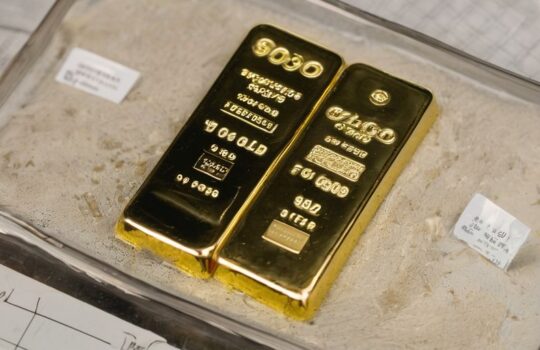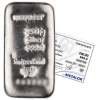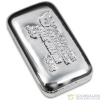Should You Buy a 1 Ounce Gold Bar?

Gold bars are a popular choice for investors looking to buy gold in bulk. They offer a tangible and secure way to own precious metal, and their value is not tied to the stock market or the dollar, making them a good hedge against inflation. However, there are pros and cons to buying a 1 ounce gold bar that should be considered. Here are the key takeaways:
Key Takeaways
- Gold bars are the most economical and practical way to buy gold in bulk.
- They work well for hedging against inflation.
- Gold bars have high purity levels and can provide ideal investment returns.
- They allow you to purchase gold in larger sizes, ranging from 1 gramme to 12,441 grammes.
- Storage and liquidity can be a concern when buying gold bars.
The History of Gold

Gold as a Currency
Gold has a long history as a currency and has been used as a medium of exchange for thousands of years. Unlike paper currencies, which can lose their value over time due to inflation, gold has maintained its value and purchasing power. This is because there is a finite supply of gold, and only a small amount is added to the supply each year through mining. Gold’s scarcity and durability make it a reliable store of value, especially during uncertain economic times. It has been regarded as a safe haven asset and a hedge against inflation.
Gold as an Investment
Gold is seen as an investment insurance policy as its value and performance don’t correlate to other assets. As a result, it tends to hold its worth and can become more desirable when markets take a turn or when inflation is high. That makes investing in gold an appealing prospect in the current economic environment.
Here are five different ways to own gold:
- Gold bullion: One of the more emotionally satisfying ways to own gold is to purchase it in bars or in coins.
- Gold ETFs: Exchange-traded funds (ETFs) offer a convenient way to invest in gold without physically owning the metal.
- Gold mining stocks: Investing in gold mining companies can provide exposure to the gold market while also benefiting from the potential growth of the companies.
- Gold futures and options: These financial instruments allow investors to speculate on the future price of gold without owning the physical metal.
- Gold jewellery: Buying gold jewellery not only allows you to own a piece of gold but also gives you the opportunity to wear and enjoy it.
Gold as a Store of Value
Gold has been recognised as a store of value for centuries. It is often considered a hedge against inflation and a safe haven asset in uncertain times. Unlike paper currencies, which can lose their spending power over time, gold has a finite supply. Only a small amount is added to the supply each year from mining. This limited supply contributes to its value and makes it an attractive investment option. Investors perceive gold as a defensive store of value, as it is generally not highly correlated to other assets. Here are some reasons why gold is valued as a store of value:
- Limited supply: Gold has a finite supply, which helps maintain its value over time.
- Hedge against inflation: Gold is often seen as a hedge against inflation, as its value tends to rise during periods of high inflation.
- Diversification: Gold can help diversify investment portfolios and reduce overall volatility.
Investing in gold can provide stability and protection against economic uncertainties.
Understanding Gold Bars

Different Types of Gold Bars
Gold bars come in a variety of sizes, ranging from 1 gramme to 12,441 grammes (400 troy ounces). This allows you to choose a size that aligns with your financial strategy. One advantage of gold bars is their ability to serve as a hedge against inflation, as their value is not tied to the stock market or the dollar. Additionally, gold bars offer a tangible and secure way to own precious metal, making them a popular choice among investors. While gold coins can also be used for inflation hedging, not all numismatic coins will provide the same results. When considering purchasing gold bars, it’s important to evaluate the premiums above the spot price, as they can vary. By selecting gold bars, you can save money compared to other gold products. Overall, gold bars are an economical and practical option for those looking to buy gold in bulk.
Advantages of Owning Gold Bars
When it comes to owning gold bars, there are several advantages to consider. Firstly, gold bars have high purity levels, often exceeding 99.99%. This high purity allows for ideal investment returns. Additionally, gold bars can be purchased in bulk, which helps to save on premiums. Most gold products come with premiums above the spot price, but selecting gold bars can help save money. Lastly, gold bars are available in large sizes, making them a suitable option for those looking to buy gold in bulk.
Factors to Consider When Buying Gold Bars
When buying gold bars, there are several factors to consider. Understanding the value of a gold bar is crucial when selling it. Factors such as purity, weight, and size determine its value. Assessing purity can be done through acid tests, magnet tests, and checking for hallmarks. Researching reputable gold buyers and documenting the condition of the bar are important steps in the selling process.
If you’re considering buying a gold bar, here are some important factors to keep in mind:
- Market familiarity: Gold coins and bars exist in slightly different markets. Consider your familiarity with spot gold performance vs. collector coin performance.
- Investment experience: Gold coins typically cost less than bars, so they work better for novice investors.
- Sizes: Gold bars offer a variety of sizes, ranging from 1 gramme to 12,441 grammes. Choose a size that suits your financial strategy.
- Inflation hedging: Gold bars are a good option for hedging against inflation as their value is not tied to the stock market or the dollar.
In summary, when buying a gold bar, it’s important to consider factors such as purity, market familiarity, investment experience, sizes, and inflation hedging.
Pros and Cons of Buying a 1 Ounce Gold Bar

Pros of Buying a 1 Ounce Gold Bar
Investing in 1 ounce gold bars offers diversification, wealth preservation, liquidity, protection against inflation, and physical ownership. They are easily tradable, provide international investment opportunities, and have a reliable long-term performance.
One of the advantages of buying a 1 ounce gold bar is its high purity level. Gold bars have purity rates that can be higher than the purity of gold coins, with most gold bars being at least 99.99% pure. This high purity allows investors to enjoy ideal investment returns.
Another benefit of buying a 1 ounce gold bar is the low premiums. Gold bars allow you to purchase the precious metal in bulk, saving on premiums compared to other gold products. While most gold products come with premiums above the spot price, selecting gold bars can help you save money.
Additionally, 1 ounce gold bars are available in large sizes, ranging from 1 gramme to 12,441 grammes (400 troy ounces). This variety of sizes allows investors to select a size that suits their financial strategy.
Lastly, buying a 1 ounce gold bar provides the advantage of easy liquidity. Gold bars are easily tradable and provide international investment opportunities. They also offer physical ownership, allowing investors to have direct control over their investment.
Cons of Buying a 1 Ounce Gold Bar
While there are many advantages to buying a 1 ounce gold bar, it’s important to consider the potential drawbacks as well. Here are some cons to keep in mind:
How to Buy a 1 Ounce Gold Bar

Choosing a Reputable Seller
When buying a 1 ounce gold bar, it is crucial to choose a reputable seller. This ensures that you are purchasing authentic gold bars and reduces the risk of counterfeit products and scams. Here are some factors to consider when evaluating a seller:
- Dealer’s customer reviews: Check the reviews and feedback from previous customers to get an idea of the seller’s reputation.
- Product’s weight and purity details: Verify the weight and purity of the gold bar to ensure its authenticity.
- Dealer certifications and licencing: Look for certifications and licences that indicate the seller’s credibility.
- IRA eligibility: If you plan to include the gold bar in an Individual Retirement Account (IRA), make sure it meets the eligibility requirements.
- Buyback programmes: Find out if the seller offers a buyback programme, which allows you to sell your gold bar back to them when you want to liquidate.
Choosing a reputable seller is key to buying authentic gold bars in the UK.
Evaluating the Purity of the Gold Bar
When evaluating the purity of a gold bar, there are several factors to consider:
-
Fineness: The fineness of a gold bar refers to its purity level. Most gold bars have a fineness of at least 99.99%, which means they are highly pure.
-
Assayer’s Mark: Look for the assayer’s mark on the gold bar, which certifies the contents and authenticity of the bar.
-
Serial Number: Each gold bar has a unique serial number, which can be used to track its origin and ensure its authenticity.
-
Packaging: Pay attention to the packaging of the gold bar. Look for words like ‘Investment Product’ and ‘Made in Switzerland’, which indicate the bar’s quality and origin.
It’s important to carefully evaluate these factors when buying a gold bar to ensure you are getting a high-quality and genuine product.
Considering Storage Options
When it comes to storing your 1 ounce gold bar, you have a few options to consider. One option is to store the gold bar in a professional vault. This provides a highly secure storage solution, ensuring the safety of your investment. Another option is to store the gold bar at home, but this may not be the best choice for everyone. It’s important to have a high-quality safe and take necessary precautions to protect your investment. Ultimately, the decision on storage options will depend on your personal preferences and circumstances.
Factors Affecting the Price of Gold

Supply and Demand
The price of gold is influenced by several factors, with supply and demand being one of the most significant. As demand for gold increases, the price tends to rise, and vice versa. This relationship is driven by various factors, including consumer demand for gold jewellery and electronics. Additionally, economic conditions and geopolitical events can also impact the demand for gold. For example, during times of economic uncertainty or political instability, investors often turn to gold as a safe-haven asset, driving up its price. On the other hand, when the economy is strong and stable, the demand for gold may decrease, leading to a decline in its price.
Inflation and Economic Conditions
Inflation and economic conditions play a significant role in determining the price of 1 ounce gold bars in the UK. These factors, along with supply and demand, currency value, and market speculation, can influence the decision-making process for investors. It is crucial to closely monitor these factors when considering purchasing gold bars. Additionally, comparing premiums from different sellers is important to ensure a fair deal.
Geopolitical Events
Geopolitical events can have a significant impact on the price of gold. Political tensions and conflicts between countries can create uncertainty in the global economy, leading investors to seek safe-haven assets like gold. For example, during times of geopolitical instability, the demand for gold tends to increase, driving up its price. Additionally, trade disputes and economic sanctions can also affect the price of gold as they can disrupt global trade and economic growth.
Conclusion
In conclusion, purchasing a 1 ounce gold bar can be a smart investment choice for several reasons. Firstly, gold bars offer a cost-effective way to buy gold in bulk, with a variety of sizes available to suit different financial strategies. Additionally, gold bars serve as a hedge against inflation, as their value is not tied to the stock market or the dollar. Moreover, gold bars have long-term value storing capabilities, making them a reliable store of wealth. While there are some considerations such as storage and liquidity, the benefits of owning a 1 ounce gold bar outweigh the drawbacks. Therefore, if you are looking to invest in gold, a 1 ounce gold bar is definitely worth considering.
Frequently Asked Questions
What is the history of gold?
Gold has been used as a currency, an investment, and a store of value throughout history.
What are the different types of gold bars?
There are various sizes and weights of gold bars available, ranging from 1 gramme to 12,441 grammes (400 troy ounces).
What are the advantages of owning gold bars?
Gold bars are a cost-effective way to buy gold in bulk, they can hedge against inflation, and they have long-term value storing capabilities.
What factors should I consider when buying gold bars?
When buying gold bars, you should choose a reputable seller, evaluate the purity of the gold bar, and consider storage options.
What are the pros of buying a 1 ounce gold bar?
The pros of buying a 1 ounce gold bar include its lower premium over spot price compared to 1 ounce gold coins and its liquidity.
What are the cons of buying a 1 ounce gold bar?
The cons of buying a 1 ounce gold bar include the need for secure storage facilities and the lower liquidity compared to gold coins.










